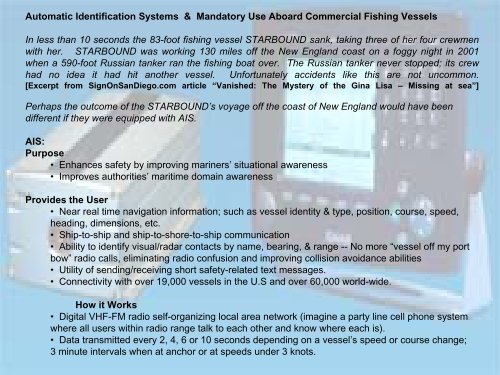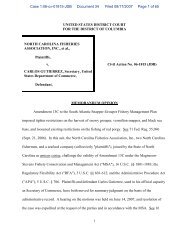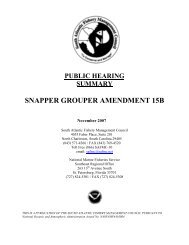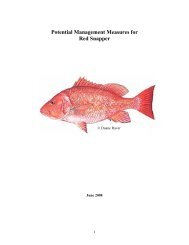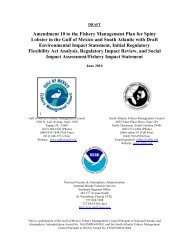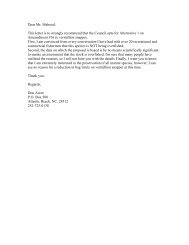Automatic Identification Systems & Mandatory Use ... - SAFMC.net
Automatic Identification Systems & Mandatory Use ... - SAFMC.net
Automatic Identification Systems & Mandatory Use ... - SAFMC.net
You also want an ePaper? Increase the reach of your titles
YUMPU automatically turns print PDFs into web optimized ePapers that Google loves.
<strong>Automatic</strong> <strong>Identification</strong> <strong>Systems</strong> & <strong>Mandatory</strong> <strong>Use</strong> Aboard Commercial Fishing Vessels<br />
In less than 10 seconds the 83-foot fishing vessel STARBOUND sank, taking three of her four crewmen<br />
with her. STARBOUND was working 130 miles off the New England coast on a foggy night in 2001<br />
when a 590-foot Russian tanker ran the fishing boat over. The Russian tanker never stopped; its crew<br />
had no idea it had hit another vessel. Unfortunately accidents like this are not uncommon.<br />
[Excerpt from SignOnSanDiego.com article “Vanished: The Mystery of the Gina Lisa – Missing at sea”]<br />
Perhaps the outcome of the STARBOUND’s voyage off the coast of New England would have been<br />
different if they were equipped with AIS.<br />
AIS:<br />
Purpose<br />
• Enhances safety by improving mariners’ situational awareness<br />
• Improves authorities’ maritime domain awareness<br />
Provides the <strong>Use</strong>r<br />
• Near real time navigation information; such as vessel identity & type, position, course, speed,<br />
heading, dimensions, etc.<br />
• Ship-to-ship and ship-to-shore-to-ship communication<br />
• Ability to identify visual/radar contacts by name, bearing, & range -- No more “vessel off my port<br />
bow” radio calls, eliminating radio confusion and improving collision avoidance abilities<br />
• Utility of sending/receiving short safety-related text messages.<br />
• Connectivity with over 19,000 vessels in the U.S and over 60,000 world-wide.<br />
How it Works<br />
• Digital VHF-FM radio self-organizing local area <strong>net</strong>work (imagine a party line cell phone system<br />
where all users within radio range talk to each other and know where each is).<br />
• Data transmitted every 2, 4, 6 or 10 seconds depending on a vessel’s speed or course change;<br />
3 minute intervals when at anchor or at speeds under 3 knots.
VMS vs. AIS<br />
The systems are not currently compatible; they differ in purpose, communication method, & capability.<br />
VMS is used as a fisheries management and enforcement tool and will remain so the near future.<br />
Satellite-based, gives periodic long-range position reports, & fishing information from vessels to shore.<br />
Information confidential to protect privacy concerns of commercial fisherman.<br />
AIS is used as a collision avoidance and Vessel Traffic Service tool.<br />
• Primarily VHF based, gives consistent navigation information to other AIS vessels<br />
• Requires an external system for long-range satellite communications<br />
• Allows vessels to be seen ship-to-ship and ship-to-shore.<br />
• No additional communications fees like VMS.<br />
WHY NOW<br />
• Marine Transportation Security Act of 2002 mandated a December 31st, 2004 deadline<br />
• Initial AIS requirements were limited to Vessel Traffic Service areas (VTSA) and those vessels coming from<br />
abroad.<br />
• Requirements were temporarily deferred outside VTSAs in order to seek further guidance on how to go about<br />
expansion of the requirements and obtain comment regarding the impact of AIS on ‘small entities’<br />
• Tragic events such as the collision between LEE III and ZIM MEXICO III, in 2004, and known intelligence on<br />
terrorists compels us to push forward.<br />
COST<br />
• Models range between $2,500 and $7,000<br />
• Additional costs for installation & level of integration of AIS with other shipboard systems like radar, gyro,<br />
charting system, etc.<br />
TIMELINE<br />
• A firm timeline will be given when the regulations are published, but, rest assured that reasonable time will be<br />
given for purchase, installation, and use of AIS.<br />
• The current regulations allotted 14 months for implementation.


